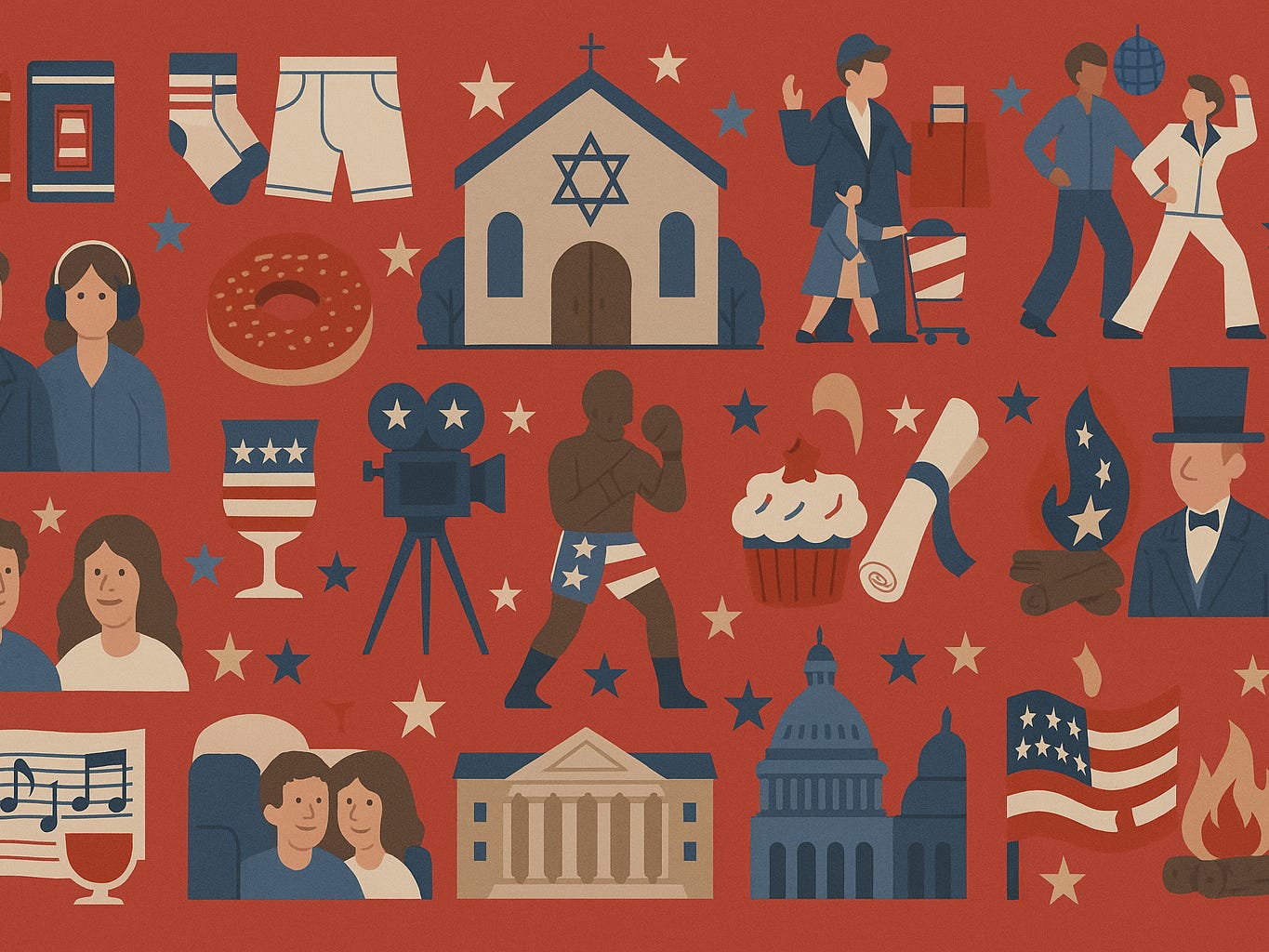An Incomplete History of Jews in America
In honor of U.S. Independence Day, this playful tour through American Jewish history reveals how a small minority helped shape the culture, quirks, and weekends of the United States.
Please consider supporting our mission to help everyone better understand and become smarter about the Jewish world. A gift of any amount helps keep our platform free of advertising and accessible to all.
The story of Jews in America isn’t just about immigration, religious freedom, or Holocaust survivors rebuilding their lives. It’s also about bagels and boxing, disco and department stores, sitcoms and senators.
It’s a tale of outsiders shaping the mainstream — not by demanding entry, but by redesigning the architecture.
From the Lower East Side to Hollywood, from union halls to Ivy League campuses, American Jews have left a mark that’s often felt more than seen. This isn’t a comprehensive account. Not even close. It’s a mosaic of quirky facts, surprising turns, and cultural oddities that remind us just how deeply intertwined Jewish life is with the American story.
Here are some of the most unexpected and delightfully strange moments in that ever-evolving saga.
1) Bagels were once radical.
In the early 1900s, the Bagel Bakers Local 338 (a union of mostly Jewish immigrant bakers in NYC) was one of the most militant and exclusive unions in America.
To join, you had to apprentice for years. They even had secret handshakes and codes.
The bagel was practically black-market: Only union bagels were “kosher.” Non-union bagels? Considered heretical.
2) Jews helped make disco cool.
Before it was associated with Studio 54 and Donna Summer, disco was pushed by Jewish producers in New York (think Neil Bogart of Casablanca Records).
Even the Bee Gees were managed by a Jewish American impresario.
Jewish DJs and club owners helped turn disco from underground dance music to a mainstream cultural force.
3) Boxing was once a Jewish sport.
In the 1920s and 1930s, Jews were dominant in American boxing. Names like Benny Leonard, Barney Ross, and Abe Attell were world champs.
Jewish parents hated it. But immigrant boys loved it; it was a way up and out.
4) The first Jew arrived in the 1600s, and was nearly deported.
Jacob Barsimson came from Holland to New Amsterdam (New York City) in 1654.
The colony’s governor, Peter Stuyvesant, tried to kick the Jews out, calling them “deceitful, repugnant, and blasphemous.”
The Dutch West India Company (run by Jewish investors) told him to shut up and let them stay.
5) Jews helped give America the two-day weekend.
In the early 1900s, Jewish factory workers who observed Shabbat (Friday night to Saturday night) were often fired for missing Saturday shifts.
In 1908, a mill in New England became one of the first to adopt a five-day workweek to accommodate Jewish laborers.
Later, Jewish-led unions (like the Ladies’ Garment Workers) helped normalize the five-day, 40-hour workweek.
6) Some of the most iconic Christmas songs were written by Jews.
“White Christmas” (Irving Berlin), “Rudolph the Red-Nosed Reindeer” (Johnny Marks), and “Let It Snow” — all written by Jews.
It’s the ultimate twist: Jews defined the soundtrack of Christian America’s favorite holiday.
7) Ellis Island changed fewer Jewish names than you think.
The myth that immigration officers renamed Jews en masse? Not really true.
Most Jewish immigrants changed their names themselves — either to blend in, avoid antisemitism, or get a job interview callback.
Hence why Goldberg became Gold, Rabinowitz became Robbins, and Blumenthal became Bloom.
8) Jews created the modern tuxedo.
The Tuxedo Club in New York, where the tuxedo made its American debut, included Jewish garment workers who actually tailored the new fashion.
The upper class wore it. The Jews stitched it. And eventually, we all wore it to bar mitzvahs.
9) The Pentagon once feared Jews were too patriotic.
During World War II, a U.S. military memo warned of “excessive Jewish enlistment” and suggested they may be overrepresented on the front lines.
Yes, the government actually worried Jews were too eager to fight Nazis.
10) The SAT was literally created to keep Jews out.
Harvard President James Conant backed the SAT (a standardized test widely used for college admissions in the United States) in the 1920s as a way to shift from “subjective” interviews (where Jews often excelled) to “objective” scores.
Ironically, Jews dominated the SAT too.
11) George Washington wrote a love letter to American Jews.
In 1790, the first U.S. president wrote a letter to the Touro Synagogue in Rhode Island promising Jews “freedom from bigotry and persecution.”
Some of his words: “May the children of the stock of Abraham who dwell in this land continue to merit and enjoy the good will of the other inhabitants — while every one shall sit in safety under his own vine and fig tree and there shall be none to make him afraid.”
Historians say that despite the letter being short, it had a big impact on the acceptance of Jews (and other religious minorities) in the United States.
Jews still cite this as one of the most radically inclusive founding documents in American history. It’s our Constitution footnote.



Yep. Jews loved boxing. Its because its a sport that all you needed was a pair of gloves and nothing else really. Plus it was finally allowed for Jews to defend themselves. Heck, my father who was a first generation American, boxed in the Golden Gloves, and even when he enlisted in the Navy.
How fun. Happy 4th and Good Shabbas, family.